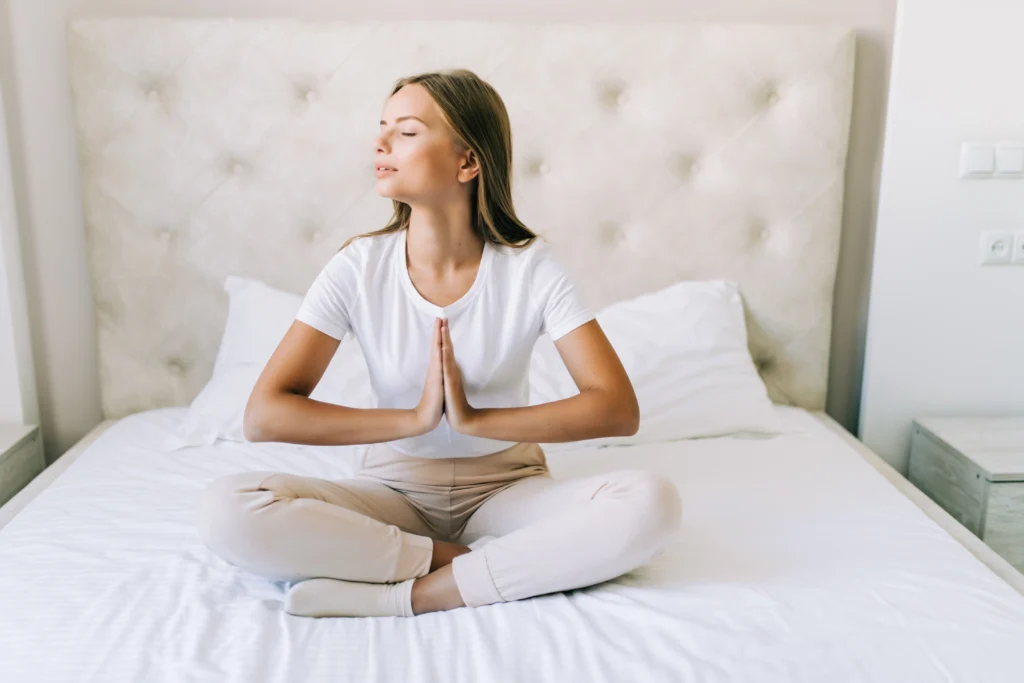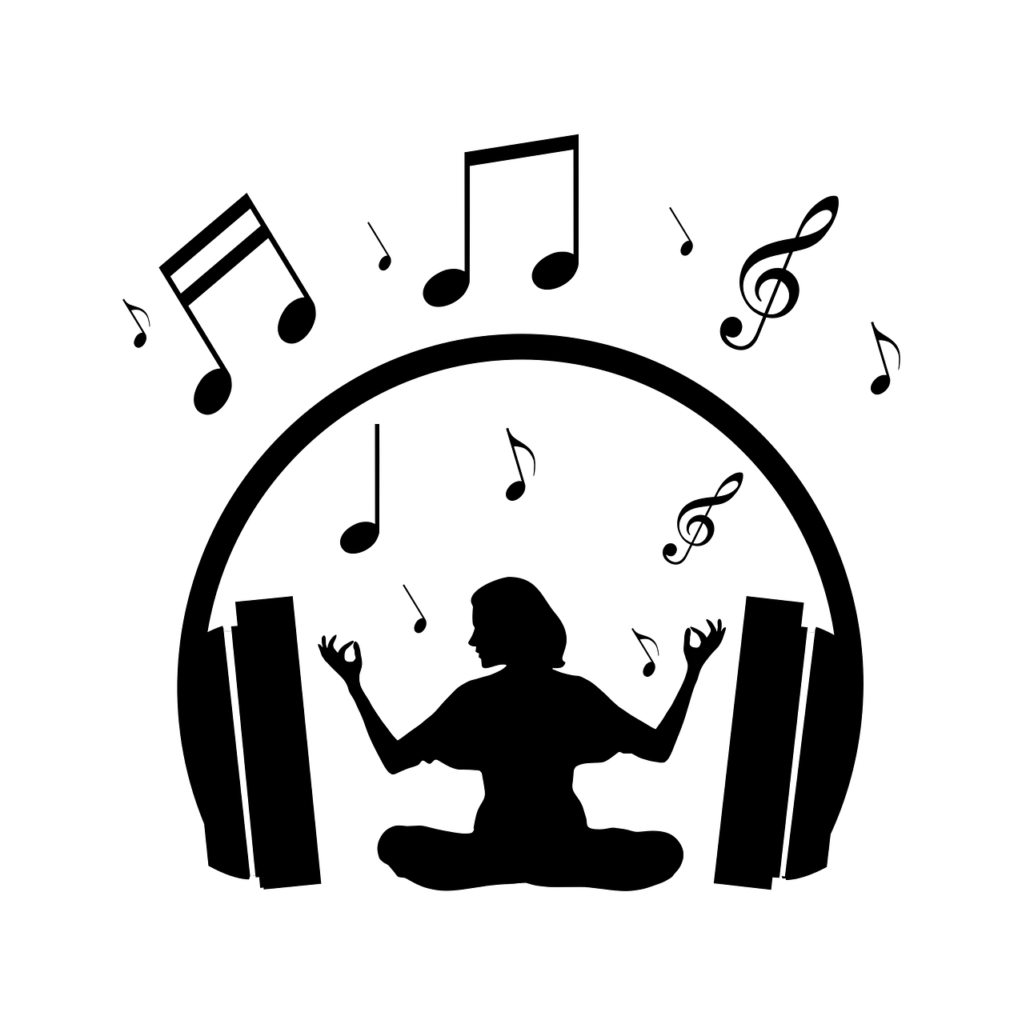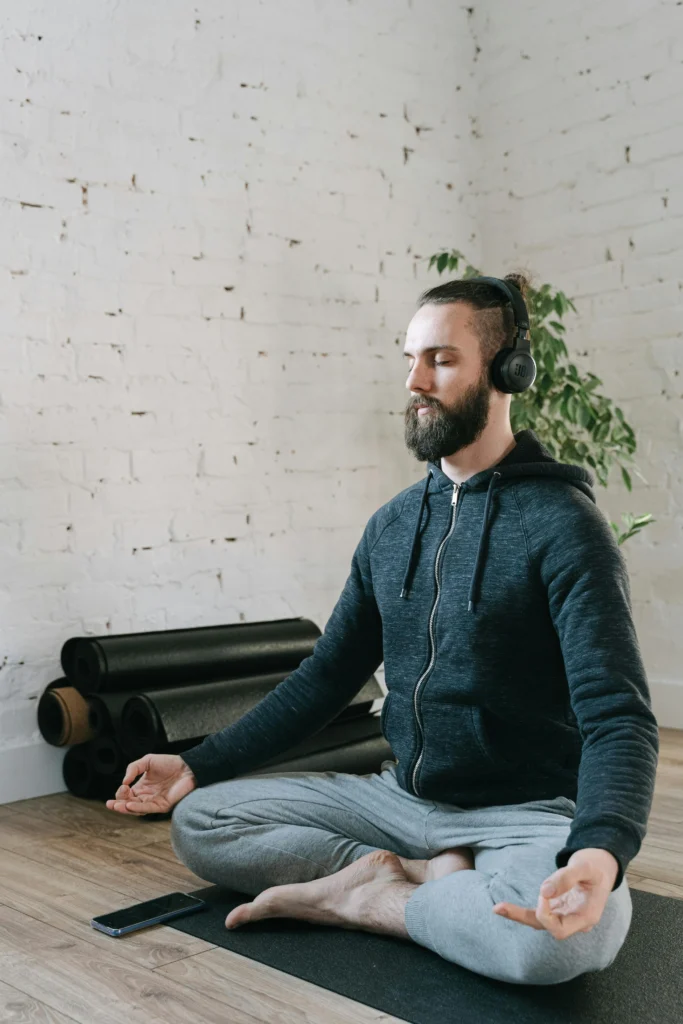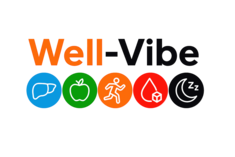Do you ever lie awake at 2 a.m., your brain whirling with tasks for the next day? You are not alone. As we reach our 40s, mastering the art of meditation is no longer a nicety but a necessity. Whether you are looking for meditation for sleep or just a brief moment of peace in the midst of your day, this age-old technique provides a refuge from the demands of life. And with the right meditation music, you may just find the peace you’ve been looking for
My Unexpected Journey into Meditation
I couldn’t imagine being “one of those meditation people,” you know, the kind smiling, ethereally serene, and somehow hovering above the fray while the rest of us mere mortals fight through rush-hour congestion and end-of-month deadlines.
Next followed my 43rd birthday, with its endearing gift of middle-of-the-night worry and 4 a.m. awakenings.
It’s just a phase, I reminded myself, guzzling my third cup of coffee before noon. Six months of fatigue later, my physician recommended what I’d been putting off: “Have you ever tried meditation for sleep?” I came close to laughing. Between career and parenting teenagers and looking after older parents who has time to sit and breathe? As it turned out, I didn’t have time not to.
Why Meditation is More Important in Midlife
Our 40s come with inherent problems that make meditation especially beneficial:
- Stress levels reach their pinnacle as we balance career demands, family requirements, and personal goals
- Quality of sleep naturally worsens with hormonal changes and stress build-up Decision fatigue rises as our responsibilities become more complex.
- Health problems arise, calling for preventive measures.
- Emotional strength becomes increasingly important for handling life changes.
- Reduce anxiety by calming the mind promote relaxation.
This is supported by research: A cross-sectional study published in the Journal of Health Psychology showed that adults in midlife who practiced mindfulness meditation for a mere 8 weeks experienced notable improvements in the quality of their sleep and their functioning during the day as compared with non-meditators (Black et al., 2015). The researchers determined that “mindfulness meditation has a part to play in treating the pervasive burden of sleep among older adults” and therefore its specific usefulness for us as we move through midlife transitions.
Ways to Meditate When You Feel Like You Can’t

Remember my early resistance? Now I’ve learned that meditation takes no more than presence.
Begin with just five minutes
Forget the hour-long sessions you’ve witnessed on Instagram. The meditation that matters is the meditation that you’ll actually end up doing. I started with five minutes every day in the morning. Five. And I placed the timer on my phone, sat at the edge of my bed, and paid attention to my breath. That is all.
My mind was not remotely serene. My thoughts flitted between presentations at work, my daughter’s college applications, and if I had defrosted dinner.
But the truth is: Being mindful of those thoughts and softly coming back to breath IS meditation. That is the practice.
Find Your Meditation Style
Every meditation approach isn’t for everybody. The following are a few that I’ve attempted:
Guided Meditation: Where independent direction is not possible, guided meditation offers a safety net. A calming voice guides you through the
experience, providing your errant mind with something to concentrate on.
Body Scan: From the tips of your toes and moving upward, you systematically relax each area of the body. Body Scan is especially beneficial for sleep meditation because it slowly releases the physical tension we often carry and are unaware of.
Walking meditation, tai chi, and light yoga are good options if you find yourself unable to sit still. Movement meditation is sometimes easier when sitting meditation is not possible.
The Brain Friendliest Meditation Music
Remember mixtapes? Think of meditation music as the ultimate mixtape for your nervous system.
The Science Behind Sound

Under the impact of sound, we are most powerfully influenced. As per a study conducted in the Journal of Advanced Nursing by McCaffrey and Locsin (2002), patients listening to soothing music for only 45 minutes witnessed:
- 35% decrease in perceived pain
- Significant drops in blood pressure and heart rate
- Quantifiable reductions in levels of anxiety
The researchers concluded that “music as a nursing intervention has the ability to reduce anxiety and facilitate relaxation” and is, therefore, the perfect accompaniment to meditation practices
Finding Your Sound

When choosing meditation music, consider:
Nature sounds Rain, ocean waves, and forest sounds access our evolutionary link with nature and activate the parasympathetic “rest and digest” nervous system.
Binaural Beats They use slightly different notes in each ear, and your brain treats this as a single pulsating sound. Most people find they make meditation easier and encourage deeper sleep.
Classical and ambient slow-tempo instrumental music keeps your mind from going down a path to follow a narrative or sing along.
The 3-Step Sleep Meditation Routine That Transformed My Life
If you’re among the 40% of adults in their 40s reporting sleep difficulties, meditation might be your missing puzzle piece.
If you are among the 40% of adults aged in their 40s experiencing difficulty sleeping, meditation could be your missing piece of the puzzle.
Step 1: Make Your Sleep Sanctuary
Your surroundings are important. I redesigned my bedroom with:
- Blackout drapes to close off the streetlight that had been my arch-nemesis
- A white noise machine to cover up my partner’s occasional snoring
- Everything electronic banned or switched off an hour prior to bedtime
- A lavender room spray that tells my brain that “it is time for bed”
Step 2: The Body Release
As I lie in bed, I start with a 10-minute body scan:
- Beginning with my toes, I contract each group of muscles for 3 seconds
- I release with a slow exhale, visualizing tension flowing out
- As I move upward systematically, I reach my forehead
- Lastly, I feel heaviness move all through my body
Step 3: The Sleep Visualization
Having my body relaxed, I transition to a sleep-inducing visualization:
I picture myself going down a staircase, counting down from 20. Every step further into relaxation. Waiting at the bottom is a cozy room where I am free to rest fully.
I dropped off to sleep before getting through the tenth step the first time I used this meditation for sleeping method.
When Things Get in the Way: Mindfulness for Everyone
“But I don’t have time to meditate!”
I understand that. But here’s the point: The American Psychological Association (2022) puts the cost of workplace stress to American companies at up to $300 billion per year in healthcare, absenteeism, and turnover. Its latest “Stress in America” survey concluded that more than 76% of adults experience symptoms of stress, including exhaustion, headache, and feeling overwhelmed all symptoms that meditation has proven to alleviate.
We feel like we don’t have time to meditate, but the truth is, we can’t afford to
Meditation Moments
Even small meditation moments can be woven into your day:
- Traffic light meditation: Utilize red lights as cues to breathe three deep breaths
- Coffee meditation: Make your morning coffee a mindfulness exercise by involving all senses in the experience
- Email pause: Pause for three mindful breaths prior to opening your inbox
- Transition meditation: Utilize the walk from your car to the office or your home as a moving meditation
Remember: Meditation isn’t about perfection, it’s about returning to presence, again and again.
Beyond Sleep: Surprising Advantages of Habitual Practice
Although better sleeping was my original target, regular meditation has yielded unexpected extra advantages:
Emotional Regulation I formerly responded immediately to triggers. Now the space between the stimulus and the response is expanding. I now have more options in responding to a challenge.
Being with others My relationships with others have grown stronger as I’ve become more present in my interactions with them. Surge of Creativity Occasionally my greatest ideas for projects now arise either during meditation itself, or shortly after, when my mind has been allowed time to reboot.
Physical Benefits My headaches, which had been persistent tension headaches, have lessened significantly and my blood pressure at my latest check-ups has been better.
Getting Started: Your Simple Meditation Plan
Getting Started: Your Simple Meditation Plan
Ready to get started? Here is a weeklong plan to build your routine:
Day 1-2: 2 minutes of Breath Awareness
Sit comfortably and concentrate only on your breath for two minutes. When your mind strays (which it will), gently bring it back to your breath.
Day 3-4: Body Scan Practice
Do a five-minute bed-time body scan, slowly bringing attention from the toes to the head, observing what is felt without judgment.
Day 5-6: Guided Meditation
Use a free app to experience guided meditation for either reducing stress or improving sleep.
Day 7: Reflection and Reset
What did you find effective? What didn’t? Modify your strategy according to your experience.
The Actual Secret: Consistency Rather Than Perfection
The strongest meditation technique is not the most sophisticated, it’s the one you consistently stick with.
Begin small. Be kind to yourself. Come back to the practice, again and again.
As my meditation teacher states, “You can’t stop the waves, but you can learn to surf.” Learning to surf is critical when the waves of life are getting in the way at the age of 40.
Your Turn: The Invitation
Tonight, when you lay in bed with the troubles of tomorrow cycling through your mind, recall this invitation:
Take only five minutes. Concentrate on your breath. If you find your mind drifting away, bring it gently back. That is all. You’ve been tending to everyone and everything else for decades. Practicing this is about finally tending to yourself as well. Will you accept this invitation?
Join our community here for weekly science-backed health tips, free meal plans, and carefully curated product recommendations delivered straight to your inbox!
Disclaimer:
This blog post is for informational purposes only and is not intended as medical advice. Always consult with a qualified healthcare professional before making any changes to your diet, exercise routine, or healthcare plan. The information provided is based on personal research and experience and may not apply to everyone



